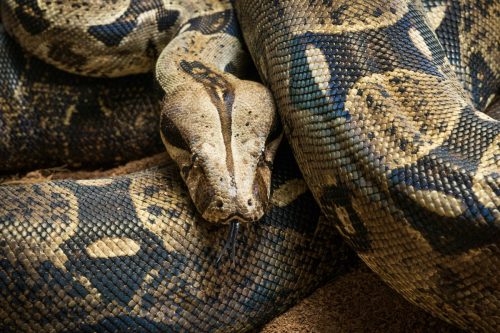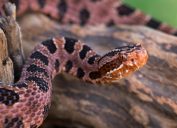"Very Scary" 10-Foot Boa Constrictor Found in Man's Backyard
More harrowing snake sightings are being reported across the U.S.

You can't read the news without hearing about the latest unnerving snake encounter. Back in May, a Facebook video showing a rattlesnake swimming across a lake in California went viral, with users saying it gave them a "new fear" to worry about. And all summer there have been reports of venomous copperhead bites across the U.S. Now, a new snake species has caused a scare in Virginia. Read on to find out more about the 10-foot boa constrictor that was just found in a man's backyard.
RELATED: 17-Year-Old Bitten by Rattlesnake in His Home—Where It Was Hiding.
A 10-foot boa constrictor was found in a man's backyard.

A Virginia man recently got the the shock of his life. Michael Peck was mowing his yard in Virginia Beach when he came face-to-face with a red-tailed boa constrictor, local NBC-affiliate 10 On Your Side reported on July 26.
According to the news outlet, the nearly 10-foot long was spotted slithering around as Peck was cutting the grass.
"At first I just kind of shrieked as a normal person would seeing a snake of that size," he told 10 On Your Side. "I have a little miniature dachshund. A snake that size could easily strangle and swallow my dog."
RELATED: 8 Things in Your Yard That Are Attracting Snakes to Your Home.
He said the sight was "very scary."

Peck was able to recognize the creature as a red-tailed boa constrictor, because he used to own one himself, according to 10 On Your Side.
"I love snakes," he told the news outlet. "I used to own a red-tailed boa that almost got to the size that he or she was."
But that doesn't mean the unexpected sight of the snake didn't cause Peck to freeze in place.
"I'm very comfortable around those types of animals. It's just very scary seeing it out in the wild out of nowhere," he explained.
RELATED: Giraffe-Sized Python Found in the U.S.—Why They're Unstoppable.
The snake was taken in by one of the man's friends.

Peck told 10 On Your Side that the 10-foot boa constrictor appeared to be in distress when he spotted it, but it wasn't showing any signs of aggression.
"She seemed very docile, just looked like she was worn out, dehydrated and needed to regain some strength," he said. "I filled a little kids' pool up just to see if she needed some water."
While it's not clear where the boa constrictor came from, Peck has his theories.
"I think she either escaped or maybe somebody let her go because she got too big," he told the news outlet.
The reptile was retrieved several hours later by one of Peck's friends, according to 10 On Your Side.
"I have a very good friend who is in love with snakes, fascinated by them, owns plenty of them and he wanted to do the right thing and take care of it until the owner steps up," Peck shared.
RELATED: For more up-to-date information, sign up for our daily newsletter.
Boa constrictors are not native to the U.S.

Boa constrictors are not venomous, but that doesn't mean they can't be dangerous. This snake species can grow up to 13 feet long and weigh well over 100 pounds, according to National Geographic.
"Their jaws are lined with small, hooked teeth for grabbing and holding prey while they wrap their muscular bodies around their victim, squeezing until it suffocates," the magazine explains. "Boas will eat almost anything they can catch, including birds, monkeys, and wild pigs. Their jaws can stretch wide to swallow large prey whole."
This creature is also not native to the U.S., and is typically found in tropical climates throughout Central and South America. But according to the United States Geological Survey (USGS), non-native boa constrictors have been located in certain parts of southern Florida alongside other giant constrictor species, like the Burmese python.
"Several are known or suspected to be breeding and appear to be spreading northward," the USGS warns on its website. "Increasingly, media and other reports of sightings or encounters with these animals have emphasized the dangers they could impose on native species, ecosystems, pets, and people."





















